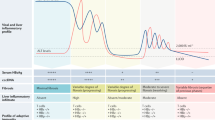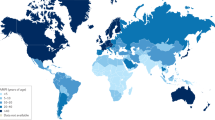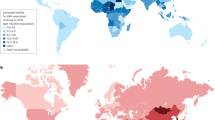Abstract
Chronic infection with hepatitis B affects nearly 350 million individuals worldwide and is the leading cause of hepatocellular carcinoma and liver cirrhosis. Universal infant immunization has decreased rates of HBV infection, although transmission continues to occur via vertical (mother-to-child) and horizontal (sexual, parenteral and household) routes. Treatments are now available for children with chronic HBV infection, but appropriate selection of those most likely to respond to treatment is important. Interferon α and lamivudine are currently approved in the US for the treatment of children older than 2 years of age who have chronic HBV infection. Hepatitis C infection affects almost 170 million individuals worldwide. Of individuals exposed to HCV, 60–80% develop chronic hepatitis, and 10–15% of those chronically infected develop cirrhosis within several decades. No vaccine exists for HCV; therefore, prevention of parenteral transmission is important. A high index of suspicion is essential for the diagnosis of HCV infection given its silent clinical presentation. Appropriate evaluation of infected individuals is warranted when considering their suitability for therapy. Interferon α and ribavirin, used in combination, are currently approved in the US for the treatment of children older than 3 years of age with chronic HCV infection.
Key Points
-
The implementation of universal infant hepatitis B immunization has reduced vertical transmission rates by 85–90%, and has similarly reduced the rates of hepatocellular carcinoma due to hepatitis B
-
Without prophylaxis, neonates exposed to HBV have a greater than 90% risk of developing chronic infection, in comparison to adults, who, when exposed, only have a 2–10% risk of developing chronic infection
-
Determination of active viral infection and associated hepatocellular inflammation is important when considering antiviral therapy for patients with chronic hepatitis B
-
HCV infection usually occurs without symptoms, and most infected individuals develop chronic infection
-
HCV genotype is important in the prediction of treatment response to antiviral therapy
-
Liver biopsy is imperative to determine the degree of hepatocellular injury from chronic hepatitis C
This is a preview of subscription content, access via your institution
Access options
Subscribe to this journal
Receive 12 print issues and online access
$209.00 per year
only $17.42 per issue
Buy this article
- Purchase on Springer Link
- Instant access to full article PDF
Prices may be subject to local taxes which are calculated during checkout


Similar content being viewed by others
References
Chang M-H (2001) Viral hepatitis and its prevention in children. In Viral and Nonviral Liver Infections. Intl Sem Pediatr Gastroenterol Nutr 10: 1–7
Mast EE et al. (1999) Strategies to prevent and control hepatitis B and C virus infections: a global perspective. Vaccine 17: 1730–1733
World Health Organization (2000) Fact sheet no 204: hepatitis B. Geneva: World Health Organization
McQuillan GM et al. (1999) Prevalence of hepatitis B virus infection in the United States: the National Health and Nutrition Examination Surveys, 1976–1994. Am J Public Health 89: 14–18
Goldstein ST et al. (2002) Incidence and risk factors for acute hepatitis B in the United States, 1982–1998: implications for vaccination programs. J Infect Dis 185: 713–719
Kidd-Ljunggren K et al. (2006) High levels of hepatitis B virus DNA in bodyfluids from chronic carriers. J Hosp Infect 64: 352–357
Diel R et al. (2005) Transmission of hepatitis B in Hamburg, Germany, 1998–2002: a prospective, population-based study. Med Microbiol Immunol 194: 193–199
Hahne S et al. (2004) Incidence and routes of transmission of hepatitis B virus in England and Wales, 1995–2000: implications for immunization policy. J Clin Virol 29: 211–220
Khan AJ et al. (2005) Ongoing transmission of hepatitis B virus infection among inmates at a state correctional facility. Am J Public Health 95: 1793–1799
Doganci T et al. (2005) Horizontal transmission of hepatitis B virus in children with chronic hepatitis B. World J Gastroenterol 11: 418–420
Lobato C et al. (2006) Intrafamilial prevalence of hepatitis B virus in western Brazilian amazon region: epidemiologic and biomolecular study. J Gastroenterol Hepatol 21: 863–868
Stevens CE et al. (1975) Vertical transmission of hepatitis B antigen in Taiwan. N Engl J Med 292: 771–774
Hill JB et al. (2002) Risk of hepatitis B transmission in breast-fed infants of chronic hepatitis B carriers. Obstet Gynecol 99: 1049–1052
Wang JS et al. (2003) Breastfeeding does not pose any additional risk of immunoprophylaxis failure on infants of HBV carrier mothers. Int J Clin Pract 57: 100–102
Liu CJ et al. (2006) Transmission of occult hepatitis B virus by transfusion to adult and pediatric recipients in Taiwan. J Hepatol 44: 39–46
Gacic-Dobo M et al. (2003) Global progress toward universal childhood hepatitis B vaccination, 2003. Morb Mortal Wkly Rep 52: 868–870
World Health Organization (2002) WHO vaccine preventable diseases monitoring system: 2002 global summary. Report No.: WHO/V&B/02.20. Geneva: World Health Organization
Chien YC et al. (2006) Nationwide hepatitis B vaccination program in Taiwan: effectiveness in the 20 years after it was launched. Epidemiol Rev 28: 126–135
Chang MH et al. (1997) Universal hepatitis B vaccination in Taiwan and the incidence of hepatocellular carcinoma in children. N Engl J Med 336: 1855–1859
Perz JF et al. (2006) Near elimination of hepatitis B virus infections among Hawaii elementary school children after universal infant hepatitis B vaccination. Pediatrics 118: 1403–1408
Katkov WN and Dienstag JL (1995) Hepatitis vaccines. Gastroenterol Clin North Am 24: 147–159
Greenberg DP (1993) Pediatric experience with recombinant hepatitis B vaccines and relevant safety and immunogenicity studies. Pediatr Infect Dis J 12: 438–445
Zanetti AR et al. (2005) Long-term immunogenicity of hepatitis B vaccination and policy for booster: an Italian multicenter study. Lancet 366: 1337–1338
Doo E (2003) Epidemiology and immunopathogenesis of chronic hepatitis B virus infection. Curr Hep Rep 2: 79–81
Shiraki K et al. (1980) Acute hepatitis B in infants born to carrier mother with the antibody to hepatitis B e antigen. J Pediatr 97: 768–770
Bortolotti F (1996) Chronic viral hepatitis in childhood. Clin Gastroenterol 10: 185–206
Boxall EH et al. (2004) Natural history of hepatitis B in perinatally infected carriers. Arch Dis Child Fetal Neonatal Ed 89: F456–F460
Huo T-I et al. (1998) Sero-clearance of hepatitis B surface antigen in chronic carriers does not necessarily imply a good prognosis. Hepatology 28: 231–236
Lok ASF and McMahon BJ (2007) AASLD practice guidelines: chronic hepatitis B. Hepatology 45: 507–539
Wu TC et al. (1987) Primary hepatocellular carcinoma and hepatitis B infection during childhood. Hepatology 7: 46–48
Czauderna P et al. (2002) Hepatocellular carcinoma in children: results of the first prospective study of the International Society of Pediatric Oncology Group. J Clin Oncol 20: 2798–2804
Keeffe EB (1999) Vaccination against hepatitis A and B in chronic liver disease. Viral Hepatitis Rev 5: 77–88
Broderick A and Jonas MM (2004) Management of hepatitis B in children. Clin Liver Dis 8: 387–401
Kelly D (2006) Viral hepatitis B and C in children. J Royal Soc Med 99: 353–357
Jonas M et al. (2002) Clinical trial of lamivudine in children with chronic hepatitis B. N Engl J Med 346: 1706–1713
Selimoglu MA et al. (2002) Alpha interferon and lamivudine combination therapy for chronic hepatitis B in children. Pediatr Int 44: 404–408
Fontana RJ (1999) Antivirals in hepatitis B. Clin Perspec Gastroenterol 2: 207–213
Jonas MM (1996) Hepatitis C virus infection: clinical aspects and treatment with interferon alfa. Clin Ther 18 (Suppl B): S110–S125
Sokal EM et al. (1998) Interferon alfa therapy for chronic hepatitis B in children: a multinational randomized controlled trial. Gastroenterology 114: 988–995
Renault PF et al. (1987) Psychiatric complications of long-term interferon alpha therapy. Arch Intern Med 147: 1577–1580
Sokal EM et al. (2006) Long term lamivudine therapy for children with HBeAg-positive chronic hepatitis B. Hepatology 43: 225–232
Hartman C et al. (2003) Lamivudine treatment for chronic hepatitis B infection in children unresponsive to interferon. Pediatr Inf Dis J 22: 224–228
Dikici B et al. (2004) Current therapeutic approaches in childhood chronic hepatitis B infection: a multicenter study. J Gastroenterol Hepatol 19: 127–133
D'Antiga L et al. (2006) Combined lamivudine/interferon alfa treatment in immune tolerant children perinatally infected with hepatitis B: a pilot study. J Pediatr 148: 228–233
Lau GK et al. (2005) Peginterferon alfa2a, lamivudine, and the combination for HBeAG-positive chronic hepatitis B. N Engl J Med 352: 2682–2695
Perillo R et al. (1999) In vivo demonstration of sensitivity of YMDD variants to adefovir. Gastroenterology 116A: 1261
Min AD and Dienstag JL (2007) Oral antivirals for chronic hepatitis B. Clin Liver Dis 11: 851–868
Wong W and Terrault N (2005) Update on chronic hepatitis C. Clin Gastroenterol Hepatol 3: 507–520
Strader DB et al. (2004) AASLD practice guideline: diagnosis, management, and treatment of hepatitis C. Hepatology 39: 1147–1171
Alter MJ et al. (1999) The prevalence of hepatitis C infection in the United States, 1988 through 1994. N Engl J Med 341: 556–562
Gibb DM et al. (2000) Active surveillance of hepatitis C infection in the UK and Ireland. Arch Dis Child 82: 286–291
Hsu EK and Murray KF (2007) Hepatitis C virus in children. J Pediatr Infect Dis 2: 3–9
European Association for the Study of the Liver (1999) International consensus conference on hepatitis C. J Hepatol 31 (Suppl 1): S3–S8
Bortolotti F et al. (2001) An epidemiological survey of hepatitis C virus infection in Italian children in the decade 1990–1999. J Pediatr Gastroenterol Nutr 32: 562–566
Gibb DM et al. (2000) Mother-to-child transmission of hepatitis C virus: evidence for preventable peripartum transmission. Lancet 356: 904–907
Zanetti AR et al. (1998) A prospective study on mother-to-infant transmission of hepatitis C virus. Intervirology 41: 208–212
Tovo PA et al. for the Italian Study Group for HCV Infection in Children (1997) Increased risk of maternal-infant hepatitis C virus transmission for women coinfected with human immunodeficiency virus type 1. Clin Infect Dis 25: 1121–1124
England K et al. (2006) Vertically acquired pediatric coinfection with HIV and hepatitis C virus. Lancet Infect Dis 6: 83–90
Mok J et al. (2005) When does mother to child transmission of hepatitis C virus occur. Arch Dis Child Fetal Neonatal Ed 90: F156–F160
Ruiz-Extremera A et al. (2000) Follow-up of transmission of hepatitis C to babies of human immunodeficiency virus-negative women: the role of breast-feeding in transmission. Pediatr Infect Dis J 19: 511–516
Airoldi J (2006) Hepatitis C and pregnancy. Obstet Gynecol Surv 61: 666–672
American Academy of Pediatrics (2006) Hepatitis C. In: Red Book: 2006 report of the Committee on Infectious Diseases, edn 27, 355–359 (Eds Pickering LK. et al.) Elk Grove Village: American Academy of Pediatrics
Mast EE et al. (2005) Risk factors for perinatal transmission of hepatitis C virus (HCV) and the natural history of HCV infection acquired in infancy. J Infect Dis 192: 1880–1889
Vogt M et al. (1999) Prevalence and clinical outcome of hepatitis C infection in children who underwent cardiac surgery before the implementation of blood-donor screening. N Engl J Med 341: 866–870
Davison SM et al. (2006) Perinatal hepatitis C virus infection: diagnosis and management. Arch Dis Child 91: 781–785
Feld JJ and Liang TJ (2006) Hepatitis C—identifying patients with progressive liver injury. Hepatology 43 (Suppl 1): S194–S206
Chen SL and Morgan TR (2006) The natural history of hepatitis C virus (HCV) infection. Int J Med Sci 3: 47–52
Murray KF et al. (2005) Liver histology and alanine amino transferase levels in children and adults with chronic hepatitis C infection. J Pediatr Gastroenterol Nutr 41: 634–638
Hoshiyama A et al. (2000) Clinical and histologic features of chronic hepatitis C virus infection after blood transfusion in Japanese children. Pediatrics 105: 62–65
Zellos A et al. (1999) High viral load and mild liver injury in children with hemophilia compared with other children with chronic hepatitis C virus infection. J Pediatr Gastroenterol Nutr 29: 418–423
Birnbaum AH et al. (2000) Hepatitis C in children. N Engl J Med 342: 290–292
Ferenci P et al. (2005) Predicting sustained virological responses in chronic hepatitis C patients treated with peginterferon alfa-2a (40 KD)/ribavirin. J Hepatol 43: 425–433
Rizzetto M (2004) Treatment of hepatitis C virus genotype 2 or 3 with pegylated interferon plus ribavirin. J Hepatol 42: 275–278
Murray KF et al. (2007) Design of the PEDS-C trial: pegylated interferon +/− ribavirin for children with chronic hepatitis C viral infection. Clin Trials 4: 661–673
Manns MP et al. (2001) Peginterferon alfa-2b plus ribavirin compared with interferon alfa-2b plus ribavirin for initial treatment of chronic hepatitis C: a randomised trial. Lancet 22: 958–965
Fried MW et al. (2002) Peginterferon alfa-2a plus ribavirin for chronic hepatitis C virus infection. N Engl J Med 347: 975–982
González-Peralta RP et al. (2005) Interferon alfa-2b with ribavirin for children with chronic hepatitis C: efficacy, safety, and pharmacokinetics. Hepatology 42: 1010–1018
Pawlotsky J-M (2000) Hepatitis C virus resistance to antiviral therapy. Hepatology 32: 889–896
Lackner H et al. (2000) Interferon-alpha and ribavirin in treating children and young adults with chronic hepatitis C after malignancy. Pediatrics 106: 1–4
Suoglu OD et al. (2002) Does interferon and ribavirin combination therapy increase the rate of treatment response in children with hepatitis C. J Pediatr Gastroenterol Nutr 34: 199–206
Hartman C et al. (2003) The effect of early treatment in children with chronic hepatitis. J Pediatr Gastroenterol Nutr 37: 252–257
Figlerowicz M et al. (2004) Interferon alpha and ribavirin in the treatment of children with chronic hepatitis C. Eur J Pediatr 1633: 265–267
Wirth S et al. (2002) Recombinant alfa-interferon plus ribavirin therapy in children and adolescents with chronic hepatitis C. Hepatology 36: 1280–1284
Vajro P et al. (1998) Interferon: a meta-analysis of published studies in pediatric chronic hepatitis B. Acta Gastroenterol Belg 61: 219–223
Torre D and Tambini R (1996) Interferon-alpha therapy for chronic hepatitis B in children: a meta-analysis. Clin Infect Dis 23: 131–137
Cooksley WGE et al. (2003) Peginterferon alfa-2a (40kDa): an advance in the treatment of hepatitis B e antigen-positive chronic hepatitis B. J Vir Hepat 10: 298–305
Wong DKH et al. (1993) Effect of alpha-interferon treatment in patients with hepatitis B e antigen-positive chronic hepatitis B. Ann Intern Med 119: 312–323
Marcellin P et al. (2007) 76 week follow up of HBeAg positive chronic hepatitis B patients treated with telbivudine, adefovir or switched from adefovir to telbivudine. J Hepatol 46 (Suppl 1): S55
Schwarz KB et al. (2003) The safety, efficacy and pharmacokinetics of peginterferon alfa-2a (40kD) in children with chronic hepatitis C. Gastroenterology 124 (Suppl 1): A700
Wirth S et al. (2005) Peginterferon alfa-2b plus ribavirin treatment in children and adolescents with chronic hepatitis C. Hepatology 41: 1013–1018
Author information
Authors and Affiliations
Corresponding author
Ethics declarations
Competing interests
Karen F Murray has received grant/research support from Gilead, Roche and Schering-Plough. Evelyn K Hsu declared no competing interests.
Rights and permissions
About this article
Cite this article
Hsu, E., Murray, K. Hepatitis B and C in children. Nat Rev Gastroenterol Hepatol 5, 311–320 (2008). https://doi.org/10.1038/ncpgasthep1124
Received:
Accepted:
Published:
Issue Date:
DOI: https://doi.org/10.1038/ncpgasthep1124
This article is cited by
-
Diagnostik sexuell übertragbarer Infektionen
Rechtsmedizin (2015)



